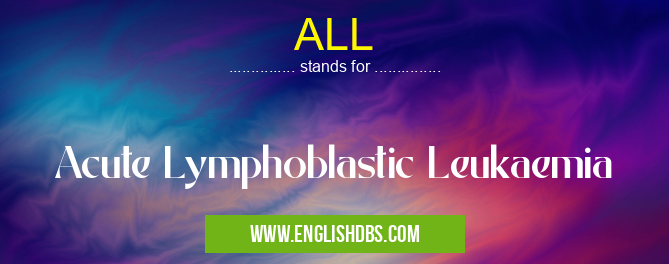What does ALL mean in CANCER
Acute Lymphoblastic Leukaemia (ALL) is a type of cancer of the blood and bone marrow. It is characterized by an overproduction of abnormal lymphocytes, which are a type of white blood cell involved in fighting infection. The majority of persons affected by this disease are children under the age of fifteen. ALL has become one of the most common childhood cancers, with an estimated 10,000 cases reported each year in the United States alone. While treatment options have improved in recent years, ALL remains difficult to treat and can be fatal if not addressed quickly and appropriately.

ALL meaning in Cancer in Medical
ALL mostly used in an acronym Cancer in Category Medical that means Acute Lymphoblastic Leukaemia
Shorthand: ALL,
Full Form: Acute Lymphoblastic Leukaemia
For more information of "Acute Lymphoblastic Leukaemia", see the section below.
Causes
The exact cause of ALL is still unknown, however it is believed to be caused by genetic mutations or environmental exposure to certain toxins or radiation. A genetic mutation occurs when there is an abnormality within a gene that disrupts how the cells reproduce, leading to uncontrolled cell growth. Environmental factors such as exposure to certain chemicals or other toxic substances may also increase the risk for developing ALL. In some cases, ALL can also run in families where there may be a genetic predisposition for the development of this type of cancer.
Symptoms
Symptoms associated with ALL will vary depending on what part of the body is affected by the disease; however some common symptoms include fatigue, fever, night sweats, increased risk of infections due to low white blood cell count and bruising due to low platelet count. Other more serious symptoms include bone pain or tenderness due to bone marrow involvement, small red spots on skin (petechiae), swollen lymph nodes and weight loss.
Diagnosis
The diagnosis process consists of a physical examination followed by blood tests and imaging tests such as X-rays, CT scans and/or PET scans for confirmation. A sample from either bone marrow biopsy or lumbar puncture may also be taken so that further analysis can be performed looking for any signs or symptoms associated with ALL.
Treatment
Treatment for ALL typically involves chemotherapy alongside other treatments such as radiation therapy and/or stem cell transplants depending on whether there is a high risk for recurrence after initial chemotherapy has been completed. In addition to these treatments other medications may also be prescribed including drugs that stimulate white blood cell production which helps reduce infections since their numbers are usually low due to chemotherapy treatment.
Essential Questions and Answers on Acute Lymphoblastic Leukaemia in "MEDICAL»CANCER"
What is Acute Lymphoblastic Leukaemia (ALL)?
Acute Lymphoblastic Leukaemia (ALL) is a type of cancer that affects the B-lymphocytes in the bone marrow and causes them to rapidly multiply, leading to an excessive amount of white blood cells.
What are the signs and symptoms of ALL?
Common signs and symptoms of ALL can include fatigue, weight loss, fever, nosebleeds, enlarged spleen or lymph glands, night sweats, petechiae (small red spots on skin caused by bleeding), and shortness of breath.
Who is most likely to be diagnosed with ALL?
ALL can happen at any age but it’s most common in children aged between 2 and 5 years old. It’s also more common in males than females.
How is ALL diagnosed?
Diagnosis usually occurs through blood tests which show low red cells, white cells and platelets counts. The doctor may also conduct a physical examination and order additional tests such as bone marrow biopsy or CT scans to check for lumps or swelling.
What are the types of treatment for this condition?
Treatment for ALL typically includes chemotherapy, radiation therapy and stem cell transplantation. Other treatments such as targeted therapy drugs may be used as well.
Are there any self-care strategies that can help manage this condition?
Yes! All patients should try to eat a balanced diet; rest when feeling tired; take breaks throughout the day; drink plenty of water; practice relaxation techniques such as yoga or meditation; exercise regularly; and get adequate sleep each night. Additionally, avoiding exposure to germs via frequent handwashing can help keep infections at bay.
What can I do if I am experiencing side effects from my treatment?
Side effects from treatment for ALL depends on what types of treatments you are receiving but could include fatigue, hair loss, nausea/vomiting, mouth sores or infection risk due to lowered immunity levels. Speak with your doctor about ways you can best manage these side effects prior to beginning treatment so you know what you need to do when symptoms occur.
Can I go back to work after receiving treatment for ALL?
That depends on several factors such as your overall health before treatment began; how well your body responds; how quickly it recovers after each session; what type/amount of work you do currently; etc. Talk with your doctor about your plans in order to create an individualised plan that works best for you!
Final Words:
Acute Lymphoblastic Leukaemia (ALL) is a form of cancer that affects both adults and children alike; if diagnosed early enough it can often be treated successfully with various treatments such as chemotherapy and radiation therapy alongside other medications for support such as those that help stimulate white blood cell production which helps protect against infections while undergoing treatment for this disease. Regardless if it's your child or yourself being diagnosed with this condition it's important to get immediate medical attention so that appropriate steps can be taken in order to achieve remission or even potentially cure this condition altogether.
ALL also stands for: |
|
| All stands for ALL |
